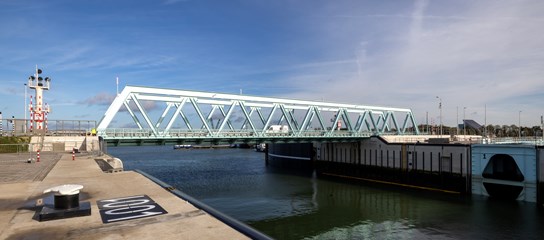New Lock Terneuzen
One of the biggest locks in the world
The New Lock in Terneuzen is one of the biggest locks in the world, comparable to the locks in Antwerp (Belgium), Panama and IJmuiden (Netherlands).
Dimensions
-
427 metres long
-
55 metres wide?
-
16.44 metres deep
Suitable for Post-Panamax vessels
-
366 metres long: That is over 100 metres longer than the largest ships that can pass through the West Lock
-
49 metres wide: One-third wider
-
14.5 metres deep: Once the Ghent-Terneuzen canal has been deepened
Centrally located on European transport corridors
The New Lock is one of the three locks of the 'North Sea Locks' complex at Terneuzen. Located within the North Sea Port port area, these locks give ocean-going vessels access to the Ghent-Terneuzen Canal from the North Sea, via the Western Scheldt, up to 32 kilometres inland. The lock complex and the Canal also represent an important link for inland navigation between the Netherlands, Germany, Belgium and northern France.
The North Sea Locks consist of the New Lock – the larger of two locks for ocean-going vessels – the East Lock for inland navigation and the West Lock for ocean-going vessels.
With the locks complex, North Sea Port is positioned on the main shipping routes for ocean-going vessels worldwide, while also being centrally located on two European transport corridors, the North Sea-Rhine-Mediterranean and the North Sea-Baltic. This ensures that goods can be delivered to their final destination quickly and efficiently by rail, road and inland waterway.
Second, larger sea lock guarantees supplies to businesses
With the New Lock, North Sea Port not only has a second sea lock but also a larger one, through which larger ocean-going vessels can sail from the North Sea towards Terneuzen and Ghent. Ships can be as much as 100 metres longer (up to 366 metres) and a third wider (up to 49 metres). And that is quite an advantage, since those larger ships – so-called Neo-panamax vessels – have become increasingly important in international trade and on shipping routes over the past twenty years.
This second sea lock, located next to the West Lock for maritime navigation, will also allow North Sea Port to guarantee permanent maritime access to the port area beyond the lock. This means an alternative will be available during maintenance on a sea lock, for example, assuring supplies to businesses at all times. In addition, this larger lock can be used to maintain the water depth of the Ghent-Terneuzen Canal, increasing reliability for the businesses served by larger ocean-going vessels.

Future Seine-Scheldt connection
As a gateway to Terneuzen and Ghent, the North Sea Locks, including the New Lock, are a crucial link in the future Seine-Scheldt connection. The development of this European inland navigation connection between the Seine and Scheldt basins will allow larger barges to sail even deeper into France from North Sea Port in the future – as far as the Paris conurbation, with a population approaching 10 million.
Committed to bigger vessels on the Ghent-Terneuzen Canal
The port authority, North Sea Port, and the companies that will use the New Lock and those larger seagoing vessels are keen to celebrate that cooperation, and to extend it in the future in order to enable larger ships from the New Lock to reach Terneuzen and Ghent within a few years. The first steps to that end have already been taken.
The port authority looks forward to 43-metre-wide vessels sailing from the New Lock to Kluizendok and Rodenhuizedok in Ghent within about three years. For a ship of this kind carrying dry or liquid bulk, that would mean several hundreds of thousands of euros in cost savings.
Get to know the New Lock
Faster transit through lock complex for barges
North Sea Port is a crucial hub for inland navigation in Europe and has direct connections by water in every direction. Which is useful for inland barges wishing to sail from Ghent and Terneuzen to the Western Scheldt and beyond to the Netherlands and Germany, or vice versa up to 32 kilometres inland (i.e. as far as Ghent), or to northern France.
The New Lock increases the capacity of the North Sea Locks at Terneuzen, which include the West Lock and the East Lock for inland navigation – allowing more barges to pass through the locks at the same time and significantly reducing waiting times. A huge asset, therefore, in making inland navigation a more reliable and attractive transport option.
Over 60% of all transport between the port and the hinterland is already provided by inland shipping.
An impressive construction project
The client for the construction of the New Lock is the Flemish-Dutch Scheldt Commission (VNSC). The New Lock was built by the Sassevaart consortium, a partnership between Dutch and Belgian companies BAM Infra, Stadsbader Contractors, DEME, Van Laere NV and Equans.
-
7 years
Construction period -
300,000 m³
Concrete poured -
9,5 million m³
Soil dredged
-
154 Olympic pools
The lock holds 385 million litres of water -
5 football pitches
In area


